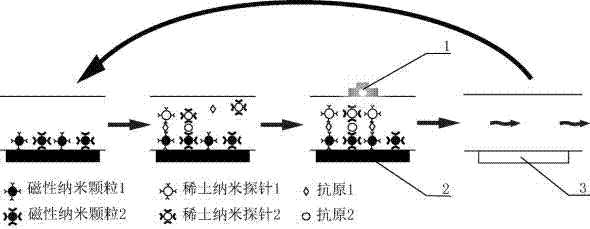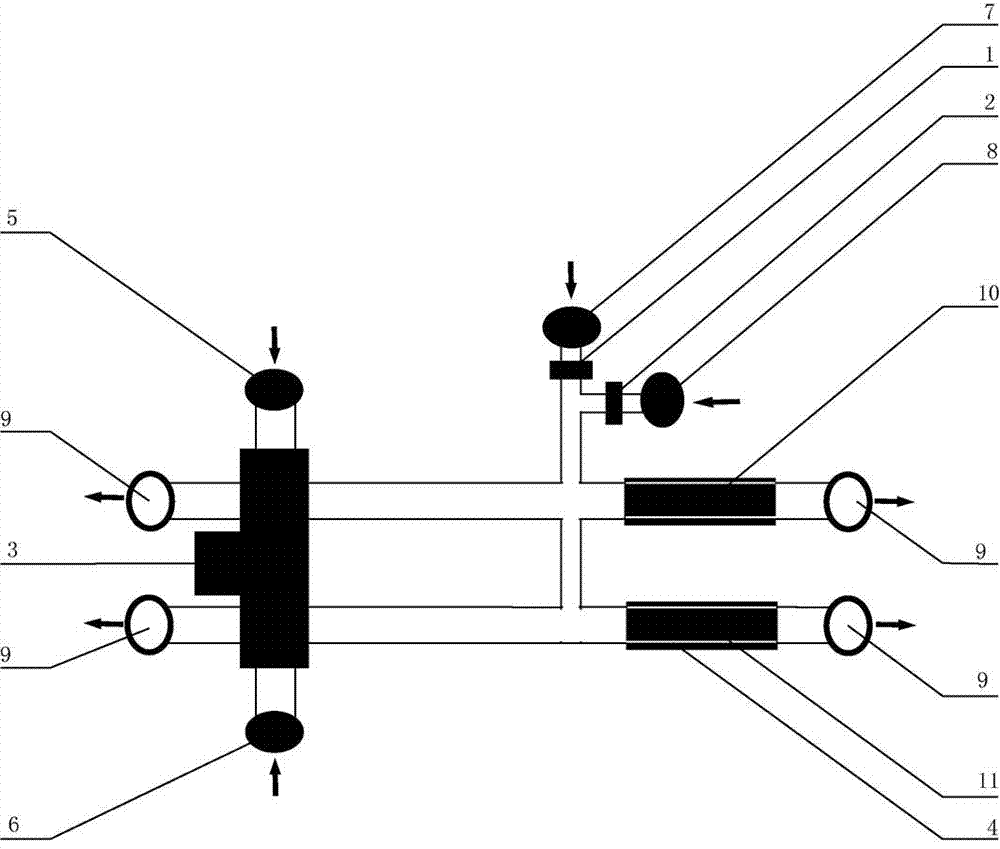Rapid and continuous detection technology based on nanometer probe and magnetic micro-nano-particles
A micro-nano particle and nano-probe technology, applied in the field of biochemical analysis, can solve problems such as lack of detection technology, and achieve the effects of improving throughput, saving cost and time, and simplifying the detection process
- Summary
- Abstract
- Description
- Claims
- Application Information
AI Technical Summary
Problems solved by technology
Method used
Image
Examples
Embodiment 1
[0044] Example 1: A continuous and rapid protein detection platform based on rare earth fluorescent nanoprobes, magnetic micro-nano particles and microfluidic chips
[0045] The schematic diagram of the microfluidic channel involved in this embodiment is as follows figure 2 shown. In the following description, "magnetic nanoparticle 1" represents the magnetic nanoparticle whose surface is modified with protein 1 monoclonal antibody, "magnetic nanoparticle 2" represents the surface modified magnetic nanoparticle with protein 2 monoclonal antibody, "rare earth nanoprobe 1" represents the rare earth nanoprobe whose surface is modified with protein 1 monoclonal antibody, and "rare earth nanoprobe 2" represents the rare earth nanoprobe whose surface is modified with protein 2 monoclonal antibody. The rare earth nanoprobes can be rare earth fluorescent nanoparticles based on elements such as Eu, Gd, Tb, Dy and Yb.
[0046] First, form the nanoimmune substrate:
[0047] Step 1) App...
Embodiment 2
[0060] Example 2: A nucleic acid continuous and rapid detection platform based on gold nanoparticle probes, magnetic micro-nanoparticles and microfluidic chips
[0061] In the following description of this embodiment, "magnetic nanoparticle 1" represents the magnetic nanoparticle whose surface is modified with the complementary sequence of nucleic acid 1, "magnetic nanoparticle 2" represents the magnetic nanoparticle whose surface is modified with the complementary sequence of nucleic acid 2, and "gold nanoprobe Needle 1" represents the gold nanoparticle probe whose surface is modified with the complementary sequence of nucleic acid 1, and "gold nanoprobe 2" represents the gold nanoparticle probe whose surface is modified with the complementary sequence of nucleic acid 2. Wherein, the gold nanoprobes may be gold nanoparticles with different shapes (such as gold nanoparticles, gold nanodiscs, gold nanotriangles, etc.) or different sizes with different ultraviolet-visible absorpt...
Embodiment 3
[0076] Example 3: A continuous and rapid nucleic acid detection platform based on heavy metal electrochemically active nanoprobes, magnetic micro-nanoparticles and microfluidic chips
[0077] In the following description of this embodiment, "magnetic nanoparticle 1" represents the magnetic nanoparticle whose surface is modified with the complementary sequence of nucleic acid 1, "magnetic nanoparticle 2" represents the magnetic nanoparticle whose surface is modified with the complementary sequence of nucleic acid 2, and "heavy metal nanodetector Needle 1" represents the heavy metal nanoprobe whose surface is modified with the complementary sequence of nucleic acid 1, and "heavy metal nanoprobe 2" represents the heavy metal nanoprobe whose surface is modified with the complementary sequence of nucleic acid 2. Wherein, the heavy metal nanoprobes may be nanoparticles containing heavy metal elements such as Cr, Fe, Ni and Cu. Moreover, electrodes (such as conductive glass ITO and F...
PUM
 Login to View More
Login to View More Abstract
Description
Claims
Application Information
 Login to View More
Login to View More - R&D
- Intellectual Property
- Life Sciences
- Materials
- Tech Scout
- Unparalleled Data Quality
- Higher Quality Content
- 60% Fewer Hallucinations
Browse by: Latest US Patents, China's latest patents, Technical Efficacy Thesaurus, Application Domain, Technology Topic, Popular Technical Reports.
© 2025 PatSnap. All rights reserved.Legal|Privacy policy|Modern Slavery Act Transparency Statement|Sitemap|About US| Contact US: help@patsnap.com


